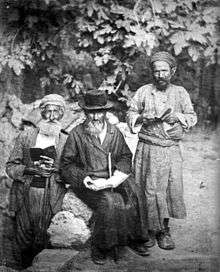Pre-Modern Aliyah
| Part of a series on |
| Aliyah |
|---|
 |
| Jewish immigration to the Land of Israel |
| Concepts |
| Pre-Modern Aliyah |
| Aliyah in modern times |
| Absorption |
| Organizations |
| Related topics |
| Old Yishuv |
|---|
 |
| Key events |
| Key figures |
|
| Economy |
| Philanthropy |
| Communities |
| Synagogues |
| Related articles |
From the time of the first Jewish exile during Assyrian Rule in Eretz Israel in 733 BCE, throughout 2,000 years of dispersion, many Jews aspired to return to their ancestral homeland. They immigrated as singles, in small groups, with or without immigration permits, and requested to live and be buried in the Land of Israel. The first in this category was "the Return to Zion", in which the Jews returned to the land of Israel from the Babylonian exile following a decree by the Persian King Cyrus, the conqueror of the Babylonian empire in 538 BCE.
The term "the Return to Zion" was later on borrowed from this event, and adopted as the definition to all the modern immigrations of Jews to the land of Israel. The period between the biblical Return to Zion and the 20th century Zionist movement, consisted of many attempts of small groups to immigrate to the land of Israel. This period, could be roughly divided into two:
- The immigrations during the Middle Ages and during the period of Renaissance - a number of immigrations which happened during different occasions in different periods and also differed in the motives that eventually caused them to immigrate.
- The immigrations during the modern era (18th century and at the start of the 19th century), three immigration waves caused by religious Zionist motives, which happened during a period of over thirty years. In these immigration waves over 750 immigrants came to Israel, which consisted of about 10 percent of the Jewish settlement in the Land of Israel with a total population of about 6000 people. These were very small immigration waves in comparison with the first Zionist ones which meant over 10,000 immigrants each.
The number of Jews returning to the Land of Israel from the Jewish diaspora rose significantly between the thirteenth and nineteenth centuries, mainly due to a general decline in the status of Jews across Europe and an increase in religious persecution. The expulsion of Jews from England (1290), France (1394), Austria (1421) and Spain (1492) were seen by many as a sign of approaching redemption and contributed greatly to the messianic spirit of the time.
Aliyah was also spurred during this period by the resurgence of messianic fervor among the Jews of France, Italy, the Germanic states, Russia and North Africa. The belief in the imminent coming of the Jewish Messiah, the gathering of the exiles and the re-establishment of the Kingdom of Israel encouraged many with few other options to make the perilous journey to the Holy Land.
Pre-Zionist resettlement in Palestine met with various degrees of success. For example, little is known of the fate of the 1210 "aliyah of the three hundred rabbis" and their descendants. It is thought that few survived the bloody upheavals caused by the Crusader invasion in 1229 and their subsequent expulsion by the Muslims in 1291. After the fall of the Byzantine Empire in 1453 and the expulsion of Jews from Spain (1492) and Portugal (1497), many Jews made their way to the Holy Land. Then the immigration in the eighteenth and early nineteenth centuries of thousands of followers of various Kabbalist and Hassidic rabbis, as well as the disciples of the Vilna Gaon (see Perushim) and the disciples of the Chasam Sofer, added considerably to the Jewish populations in the Four Holy Cities (Jerusalem, Tiberias, Hebron, and Safed).
There were also those who like the British mystic Laurence Oliphant tried to lease Northern Palestine to settle the Jews there (1879).
Unsuccessful attempts
- Judah Halevi (1075-1141) – seems to have died en route in 1140.[1][2]
- Meir of Rothenburg (1215–1293) – arrested in 1286 and imprisoned.
- Naphtali Cohen (1649–1718) – died in Constantinople en route.
- Israel Baal Shem Tov (d. 1760) – a series of tragedies prevented his trip.
- Vilna Gaon (1720–1797) – unsuccessful attempt in 1780.
- Yisrael Meir Kagan (1838–1933) – planned to settle in Petach Tikvah, but departure delayed for various reasons.
- Fioretta Modena (1524–1580) – left Italy but died before reaching Safed.
See also
References
- ↑ How to Be a Jew: Ethical Teachings of Judaism. Byron L. Sherwin, Seymour J. Cohen - 1992. pg. 10. "A central theme both in Ha-Levi's poetry and in the Kuzari is the centrality of the Land of Israel to Judaism and the longing of the Jewish people (and of Ha-Levi himself) for the Holy Land. Ha-Levi's concern with the Land of Israel led him to leave Spain for Palestine in 1139. It does not seem, however, that Ha-Levi ever reached his destination. He seems to have died en route in 1140 or 1141."
- ↑ Mircea Eliade, Charles J. Adams - 1987. The Encyclopedia of religion - Volume 15 - Page 506: "In the summer of 1140, various personal, political, and religious considerations prompted him to depart for Palestine. Legend claims that he was killed within sight of Jerusalem, although recent studies suggest that he died en route, in Egypt."